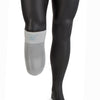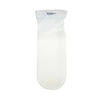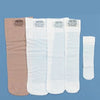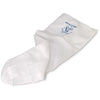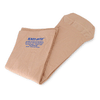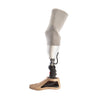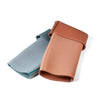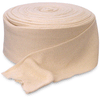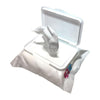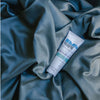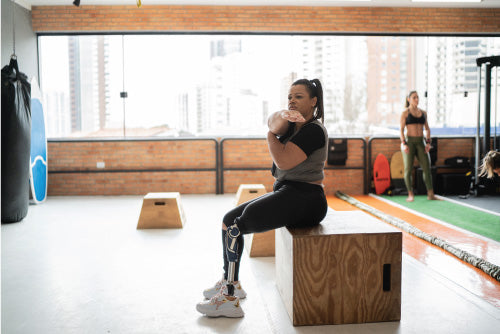Which prosthetic sock is right for me?
As with activity specific clothing, there are different types of amputee socks designed for optimum performance under specific conditions, and the type you choose will largely be determined by when you plan on using them and what performance priorities you value. A thick 5-Ply, wool sock with X-Static, for example is ideal when odor management and cushion are priority and perspiration is secondary. Applying this same X-Wool by Knit-Rite sock underneath your prosthetic liner to help with odor causing bacteria would create a critical suspension issue. In this example, the ideal prosthetic sock would be the Liner-Liner prosthetic sock by Knit-Rite for underneath your gel liner. During your search for prosthetic socks, you may find that a mixture of specialized-appropriate socks is ideal.
Some of the main things to consider when purchasing prosthetic socks are:
- Materials:Prosthetic socks can be made of either natural materials such as wool or cotton, or man-made textiles including Lycra, nylon or a blend of multiple fibers. For sporting and technical wear, synthetic fibers are generally preferred as they are engineered to offer excellent breathability, insulation and wicking (the ability to draw moisture from the skin to the surface of the fabric) properties. In general, socks that contain Lycra can accommodate a wide variety of residual limb shape and sizes. If sweating is a serious issue look for socks that contain Coolmax fibers that pulls moisture away from your skin to keep you drier and cooler in the summer. Wool is an excellent material for active amputees, having natural breathability and wicking properties, as well as being resistant to the buildup of odor and bacteria.
- Length:Amputee Socks are typically worn 3 inches (7.5 cm) past a socket's below knee trimelines. Above knee amputees typically prefer to wear socks that they can reflect over the top of brim creating a soft transition.
- Gel Impregnated socks:Few things are more irritating than skin irritation related to friction, so a gel impregnated socks is a valuable addition to any amputee sock supply. Worn in conjunction or in lieu of non-gel socks they can absorb shear stress while offering extra cushion. Gel stump socks that are manufactured using mineral oil gel release vitamins and can keep your skin moisturized and healthier. Keep in mind that unless the gel sock is coated on both the inside and outside with fabric you may sweat more than usual.
- Thermal qualities:Socks with thermal properties – socks that contain Coolmax have the ability to regulate temperature within the socket. Coolmax will keep your limb warmer in the winter months and cooler in the summer.
- Moisture management:As above, all synthetic and some natural fibers (Merino wool in particular, cotton not so much) are valued for their wicking properties, that is, their ability to draw moisture away from the skin and allow it to evaporate. This is an essential consideration if you don’t want your residual to become saturated with sweat from wearing a prosthesis that can then lead to skin irritations.
- Odor management: X-Static is an antimicrobial fabric technology that is sometimes referred to as "stink free" technology. Sock manufactures from Knit-Rite to Silipos to Royal Knit offer prosthetic socks that have X-Static part of the fabric blend. X-Static inhibits odor causing bacteria, that if left uncheck can will create a smelly sock.
Finally, under liner socks - sock manufacturers are beginning to create prosthetic socks for use underneath a prosthetic liner. These liner stump socks help neutralize odor causing bacteria and a few will also wick perspiration as well. Many amputees keep a few extra in their sock supply to easily exchange a sweaty sock with a fresh dry sock. Specialized for use underneath a prosthetic liner they offer the benefit of improved limb hygiene. Wear under-liner socks in conjunction with your sock regimen. Only one sock is worn underneath your liner so as not to disrupt the suspension function of your liner. The remaining sock(s) that comprise your sock routine are worn over your liner to help manage socket volume.
Material Quick Guide
Issue |
Material |
Reason |
|
Perspiration |
Wool Polyester Blends |
Wool and polyester blends dissipate perspiration over a greater surface area and wick moisture away from your limb, providing a less damp sock. Polyester blends do not retain sweat.
|
|
Sensitive Skin |
Gel Synthetic Fiber (with silver)
|
Gel dissipates pressure in sore areas Synthetic socks with silver provide anti-microbial protection from odor causing bacteria and infection Reduces shear forces |
|
Volume Fluctuation Uniquely shaped residual limbs |
Synthetic Fibers with Lycra |
Lycra is an elastic type of fiber that stretches and contracts with volume fluctuation Other synthetic fibers can have elastic properties as well Lycra conforms to irregular limb shapes, providing a better fit |
|
Odor control |
Silver Socks containing X-Static |
Make sure socks are cleaned regularly Wool, synthetic fibers, and anti-microbial infused gel have properties to reduce odor build-up
|
|
Socks with Locking Liners |
Choose a sock with pre-seamed hole-in-toe
|
Cutting holes in any sock material can cause threads to get stuck in the locking mechanism Make sure your stump sock is not in the way of your pin (if the sock is caught on the pin and inserted into the lock you may have trouble removing your prosthesis) |
|
Closed abrasions/closed sores |
Gel |
If you have high pressure areas caused by your socket, gel socks are best Gel dissipates high pressure areas by providing additional cushioning and shock absorption |
|
Pressure at the knee joint from multiple socks |
Half socks |
Half socks are great if your sinking too far into the socket Half socks replaces volume along the bottom end of your limb while leaving room at the top for knee joint mobility. Great for new amputees, where the bottom of their residual limb shrinks faster than the top. |













































